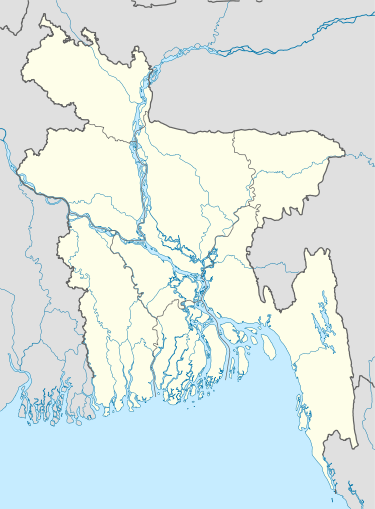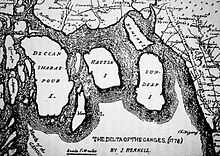Sandwip
| Native name: <span class="nickname" ">সন্দ্বীপ | |
|---|---|
|
Satellite view of Sandwip | |
 Sandwip (Bangladesh) | |
| Geography | |
| Location | Bay of Bengal |
| Coordinates | 22°29′N 91°29′E / 22.483°N 91.483°ECoordinates: 22°29′N 91°29′E / 22.483°N 91.483°E |
| Adjacent bodies of water | Bay of Bengal |
| Total islands | 3 |
| Major islands | 1 |
| Area | 762.42 km2 (294.37 sq mi) |
| Length | 50 km (31 mi) |
| Width | 5–15 km (3.1–9.3 mi) |
| Bangladesh | |
| District | Chittagong District |
| Demographics | |
| Demonym | Sandwipi |
| Population | 350,000[1] (as of 2011) |
| Density | 439 /km2 (1,137 /sq mi) |
Sandwip (Bengali: সন্দ্বীপ) is an island along the south eastern coast of Bangladesh in the Chittagong District. Also spelled Sandvip, the transliteration of the name would in fact be Shondip. It is part of the sub-district of Sandwip Upazila.
Description

It is situated at the estuary of the Meghna River on the Bay of Bengal and separated from the Chittagong coast by Sandwip Channel. It has a population of nearly 350,000. There are as many as fifteen different wards, 62 mahallas and 34 villages on Sandwip Island. The entire island is 50 kilometers long and 5-15 kilometers wide. It is located at the north-eastern side of The Bay of Bengal, nearby the main port city of Chittagong. It is bounded by Companiganj on the north, Bay of Bengal on the south, Sitakunda and Mirsharai, and Sandwip Channel on the east, Noakhali Sadar, Hatiya and Meghna estuary on the west.[2]
Etymology
There are several theories to the origin of the name Sandwip among the locals. A folk etymology claims that it was derived from European word "sand heap" over time. Others say that 12 awlia from Baghdad travelling to Chittagong discovered this island in the middle of the ocean and found no people, so they defined it as "Shunno Dwip" and which eventually became "Sandwip". And another group argues that "Sandwip" is named after Bakhorganj historian Mr. Beverage’s "Shom Dwip".[1] Some scholars have suggested that Portuguese people called it "Sandheep" (Hasan, 1999). Je the Baras marked it as "Sundina" in his map (1550). Candel Broke mentioned it as ‘Sundiva’ in his map (1660). Major Ranel mentioned it as ‘Sundeep’ in his map.[2]
History

Sandwip Island in Bangladesh has a great historical legacy. The island itself is about 3000 years old[3] and it has been ruled by many different people over the centuries, including Delwar Khan. It was a Portuguese and Arakanese pirate stronghold during the 17th century and even today some of the architecture on the island reflects this part of the island’s history. Arakanese back than used to rule part of Burma (Myanmar), Chittagong including Sandwip. Sultan Delwar Khan was the appointed Sultan in Sandwip by Arakanese leader back then. Sultan Delwar Khan was attached in 17th century by Mughal Emperor Awrangojeb. Sultan Delwar Khan was arrested and was taken to prison in current Dhaka. Sultan Delwar died while in prison. However, the governor of Bengal saw fit to put an end to this in 1665 as part of attempts to restore order there. Under British rule its location proved to be a bit of an administrative problem. Today it is well and truly a part of Bangladesh. It is supposed that Sandwip was connected with Chittagong original land and disconnected by natural disasters.[2]
Tansi reported on Lower Gangas (150) in which he included Sandwip. Sandwip is mentioned at The Baros Map (1560). Cesar Fredarich visited in Sandwip in 1565 and noted it as old island. Parcuch described 300 years old mosque in this area (1620). Sanchan the Abevel mentioned Sandwip in his drawing map and he also mentioned Vulua, Bengal, Chattagram and Dhaka with it. Sri Rajkumar Chakrabarty mentioned in his History of Sandwip about 400 or 500 years old plants (1923). It is also found in The Anvel Curt’s drawing map (1752).[2]
Agriculture
Agriculture is the main occupation of many people on the island. They cultivate Paddy, jute, potato, betel leaf, betel nut, sugarcane, Radish, potato, tomato, brinjal, cauliflower, sweet potato, corundum, carrot, etc. They cultivate fruit like water melon, mango, Jackfruit, banana, papaya, guava, kul, date etc.
Ecology
Sandwip Island has been formed by silt deposits from the estuary of the Meghna river. This makes it an incredibly fertile island – something which the people of the island have been exploiting for years. Large crops of rice, dal, vegetables, coconuts, battle leave and wheat have all been grown on the island at some point in its history. Today the main crops are melons, mangos, pineapples, gaab, jam and coconut.
Natural Disaster
In the years 1825, 1876, 1985, 1991 Sandwip was affected by devastating cyclones & tornadoes. On 29 April 1991, the most damaging storm affected the island. The death toll was about 40 thousand. 80% of the houses in Sandwip were destroyed. The velocity of the cyclone was 225km/h.[4]
Gallery
| Wikimedia Commons has media related to Category:Sandwip. |
-

Dheki (husking pedal) once was very common in houses of Sandwip
-

-

-

References
- ↑ 1.0 1.1 "Sandwip Upazila (সন্দ্বীপ উপজেলা)". Chittagong. 2011-05-26. Retrieved 2012-11-07.
- ↑ 2.0 2.1 2.2 2.3 "Sandwip Island". Ebbd.info. Retrieved 2012-11-07.
- ↑ Noakhali District Gazetters
- ↑ "The Yellow page of Sandwip - প্রাকৃতিক দূর্যোগ". Sandwip-uttaran.org. Retrieved 2012-11-07.
External links
- Ramerini, Marco, Portuguese India, The Portuguese in the Bay of Bengal
